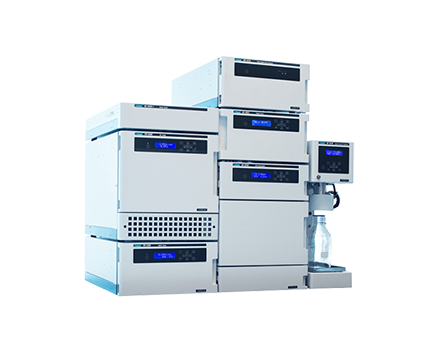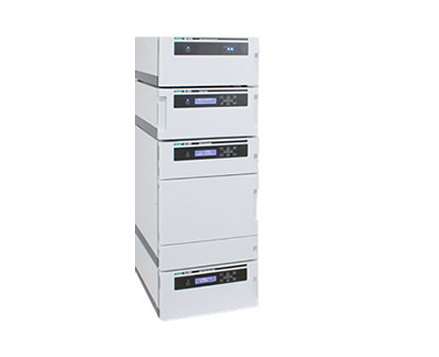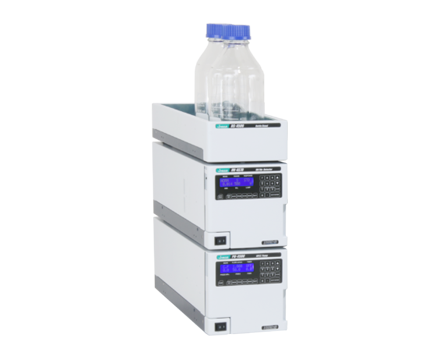Parallel SFC-MS for Rapid Chiral and Achiral Analytical and Semi- Prep Analysis
August 15, 2022
Introduction
Chiral and achiral SFC analysis requires solvent and column screening in order to determine the best solvent-column combination and provide the desired resolution for the peaks of interest. With the increasing number of chiral and achiral columns and the increase in the number of samples to analyze, higher throughput is required.
The implementation of UHPLC using shorter length and smaller particle columns has increased to address this throughput need. However, reversed-phase is not the desired separation technique for chiral separations and SFC also offers an orthogonal separation to reversed-phase for achiral compounds. In addition, smaller particle columns lead to higher pressures requiring more expensive equipment. Scale-up from UHPLC has been established, but is not as straightforward as SFC scale-up and the fraction recovery in preparative SFC is much easier with the CO2-alcohol mobile phase.
In this application, we show the parallel SFC for higher throughput in solvent and column screening for chiral and achiral analysis. The parallel SFC offers up to 10 solvents and 24 columns, but also the ability to further optimize the separation after the best solvent-column combination is determined. After the optimization, the system allows for scale-up to preparative purification.
Experimental
Flavanone, ibuprofen, ketoprofen, sulfamethazine and methanol, were purchased from Sigma-Aldrich (St. Louis, MO, USA). The terpenes sample containing 19 terpenes was obtained from Restek. The CO2 cylinder was purchased from Airgas (PA, USA). Columns were acquired from multiple suppliers: Princeton Chromatography (Princeton, NJ, USA), Phenomenex (Torrance, CA, USA) and Chiral Technologies (PA, USA). The JASCO Parallel SFC system consisted of a CO2 pump, co-solvent pump, autosampler, column oven, UV detectors, Advion CMS-L, and back pressure regulator.
Keywords
SFC 2018, SFC-MS
Results
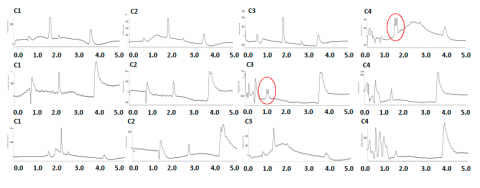
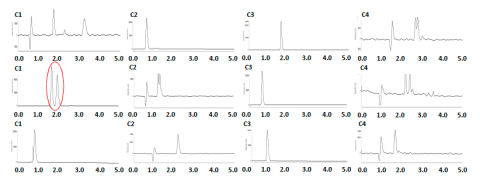
The results of the 4 column parallel screen for ibuprofen and flavanone are shown above which required only 15 minutes each to screen 12 columns. This results in the reduction in screening time by 45 minutes compared to run each column individually. The best separation is circled in red and the system also allows for further optimization on the best column without any changes.
Parallel screening in SFC not only applies to chiral separations as shown in the achiral screening of terpenes on 12 columns. Both chiral and achiral columns were used for this screen as often chiral columns have provided achiral separations. This show the ability for a simultaneous chiral and achiral screening.
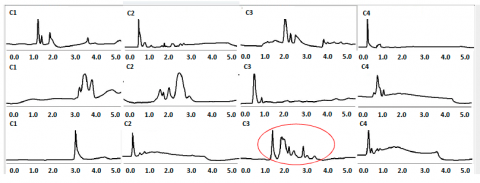
The addition of a mass spectrometer is useful for chiral separations for identity confirmation especially with the presence of impurities, but certainly offers a significant advantage for achiral separations. As shown below the 2 column parallel screening was run into the CMS mass spectrometer. With the presence of both chiral and achiral compounds, the peaks are more easily confirmed and identified with the mass spectrometer.
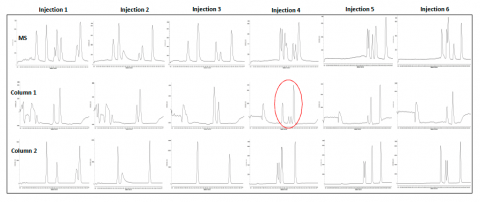
The mass spectrometer is able to detect the compounds coming from both columns and when peaks co-elute within a column or co-elute when recombined after running parallel, the mass spectrometer was able to differentiate and identify the compounds. This capability provided a powerful identification tool while still taking advantage of the speed provided by parallel screening.
Conclusion
As SFC requires column and solvent screening for both chiral and achiral separation, parallel screening significantly reduces the total analysis time. This analysis time can be reduce as much as 5 fold, but still allows for further individual column method develop after the initial screen. In addition the system also offers the ability to scale up for purification after the initial screen and separation optimization.
The addition of the mass spectrometer not only aids in chiral purifications, but is imperative for achiral separations. The power of the mass spectrometer to differentiate compounds by mass, still allows for the mass spectrometer to work with parallel SFC providing the fastest and most powerful separation technique for both chiral and achiral analysis.
Featured Products:

Parallel SFC-MS for Rapid Chiral and Achiral Analytical and Semi- Prep Analysis
Introduction
Chiral and achiral SFC analysis requires solvent and column screening in order to determine the best solvent-column combination and provide the desired resolution for the peaks of interest. With the increasing number of chiral and achiral columns and the increase in the number of samples to analyze, higher throughput is required.
The implementation of UHPLC using shorter length and smaller particle columns has increased to address this throughput need. However, reversed-phase is not the desired separation technique for chiral separations and SFC also offers an orthogonal separation to reversed-phase for achiral compounds. In addition, smaller particle columns lead to higher pressures requiring more expensive equipment. Scale-up from UHPLC has been established, but is not as straightforward as SFC scale-up and the fraction recovery in preparative SFC is much easier with the CO2-alcohol mobile phase.
In this application, we show the parallel SFC for higher throughput in solvent and column screening for chiral and achiral analysis. The parallel SFC offers up to 10 solvents and 24 columns, but also the ability to further optimize the separation after the best solvent-column combination is determined. After the optimization, the system allows for scale-up to preparative purification.
Experimental
Flavanone, ibuprofen, ketoprofen, sulfamethazine and methanol, were purchased from Sigma-Aldrich (St. Louis, MO, USA). The terpenes sample containing 19 terpenes was obtained from Restek. The CO2 cylinder was purchased from Airgas (PA, USA). Columns were acquired from multiple suppliers: Princeton Chromatography (Princeton, NJ, USA), Phenomenex (Torrance, CA, USA) and Chiral Technologies (PA, USA). The JASCO Parallel SFC system consisted of a CO2 pump, co-solvent pump, autosampler, column oven, UV detectors, Advion CMS-L, and back pressure regulator.
Results


The results of the 4 column parallel screen for ibuprofen and flavanone are shown above which required only 15 minutes each to screen 12 columns. This results in the reduction in screening time by 45 minutes compared to run each column individually. The best separation is circled in red and the system also allows for further optimization on the best column without any changes.
Parallel screening in SFC not only applies to chiral separations as shown in the achiral screening of terpenes on 12 columns. Both chiral and achiral columns were used for this screen as often chiral columns have provided achiral separations. This show the ability for a simultaneous chiral and achiral screening.

The addition of a mass spectrometer is useful for chiral separations for identity confirmation especially with the presence of impurities, but certainly offers a significant advantage for achiral separations. As shown below the 2 column parallel screening was run into the CMS mass spectrometer. With the presence of both chiral and achiral compounds, the peaks are more easily confirmed and identified with the mass spectrometer.

The mass spectrometer is able to detect the compounds coming from both columns and when peaks co-elute within a column or co-elute when recombined after running parallel, the mass spectrometer was able to differentiate and identify the compounds. This capability provided a powerful identification tool while still taking advantage of the speed provided by parallel screening.
Conclusion
As SFC requires column and solvent screening for both chiral and achiral separation, parallel screening significantly reduces the total analysis time. This analysis time can be reduce as much as 5 fold, but still allows for further individual column method develop after the initial screen. In addition the system also offers the ability to scale up for purification after the initial screen and separation optimization.
The addition of the mass spectrometer not only aids in chiral purifications, but is imperative for achiral separations. The power of the mass spectrometer to differentiate compounds by mass, still allows for the mass spectrometer to work with parallel SFC providing the fastest and most powerful separation technique for both chiral and achiral analysis.
Keywords
SFC 2018, SFC-MS

 Download This Application
Download This Application